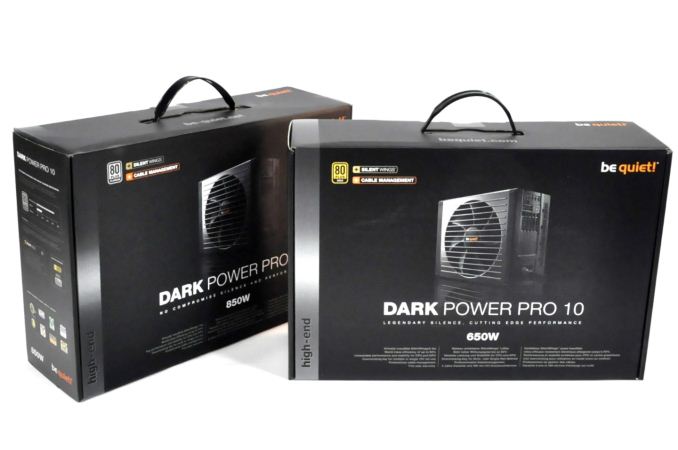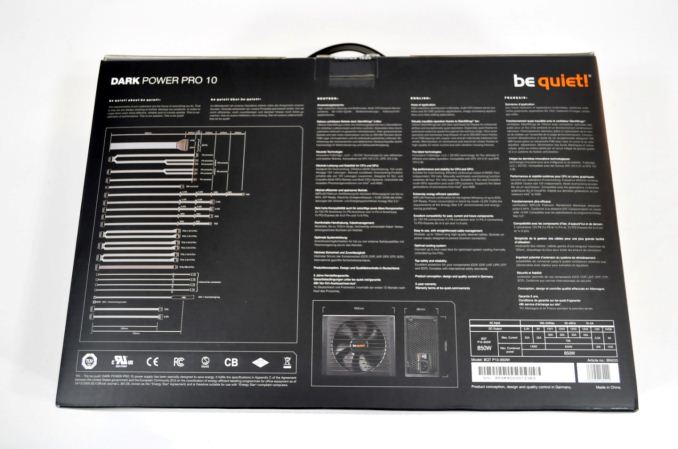Be Quiet! Dark Power Pro 10 650W & 850W PSU Review
by E. Fylladitakis on February 2, 2015 11:40 AM EST
Introduction
be quiet! is a German company that is slowly making their way into the North American market. As its name suggests (and yes, the correct spelling is all lowercase), the company specializes in creating low-noise components for PCs, mainly cooling and power related. We had the chance to see some of their new products, including their first case, at CES. The last of their products that we reviewed was the Power Zone 850W power supply, which was a bit disappointing in that it was unable to catch up with the competition and not quite quiet under heavy loads.
Our review did not phase the company, who sent us samples of their best PSU series, the Dark Power Pro, for another review. This series is strictly aimed towards enthusiasts and advanced users, seeking the very best parts available for their systems. It consists of six units, ranging from 550W up to 1200W. be quiet! supplied us with samples of their 650W and 850W models, as their reasonable power output makes them the "best sellers" of the series. However, there are large variations between the models of the series, which can be seen from the fact that only the 850W unit is 80 Plus Platinum certified – the rest of the Dark Power Pro 10 units all have a 80 Plus Gold certification. As such, we expect the two units that we will review today to be significantly different, even though they are part of the same series.
| be quiet! Dark Power Pro 10 650W Power specifications ( Rated @ 50 °C ) |
|||||
| AC INPUT | 100 – 240 VAC, 50 – 60 Hz | ||||
| RAIL | +3.3V | +5V | +12V | +5Vsb | -12V |
| MAX OUTPUT | 25A | 25A | 54A | 3A | 0.5A |
| 125W | 648W | 15W | 6W | ||
| TOTAL | 650W | ||||
| be quiet! Dark Power Pro 10 850W Power specifications ( Rated @ 50 °C ) |
|||||
| AC INPUT | 100 – 240 VAC, 50 – 60 Hz | ||||
| RAIL | +3.3V | +5V | +12V | +5Vsb | -12V |
| MAX OUTPUT | 25A | 25A | 70A | 3A | 0.5A |
| 140W | 840W | 15W | 6W | ||
| TOTAL | 850W | ||||
Packaging and Bundle
Both Dark Power Pro 10 units share a virtually identical packaging, with the obvious differences being the power rating and the 80 Plus certification badge. It is a very professional looking, sturdy cardboard box, with thick layers of polystyrene foam offering sufficient shipping protection. Ample information on the features, specifications and even the length of the cables is printed on the back of the box.
be quiet! treats the Dark Power Pro 10 as the top-tier units they are supposed to be and provides a wealthy bundle with these units. Inside the box we find a manual, the typical AC power cable, five black screws, five thumbscrews, several cable ties, six quality cable straps, a jumper for the OCK mode, and a switch with an LED mounted on an expansion slot cover.
We should note that there are five screws and five thumbscrews, even though that the PSU requires four, because be quiet! offers a spare just in case one gets lost. These screws are longer than typical 3M case screws, which are not sufficiently long for the proper installation of the power supply.
Regarding the OCK mode, it is a feature that the Dark Power Pro 10 units offer, allowing the user to "merge" the four 12V lines into one. This can be done by using the provided jumper, which will lock the Dark Power Pro 10 to a single rail OCP monitoring mode, or by installing the expansion cover with the switch, allowing for on-the-fly mode changes. Obviously, the power output of the unit does not get any more powerful; OCK simply overrides the stock OCP (over current protection) configuration, ceasing the monitoring of separate 12V rails and monitoring the entire 12V line as a whole.
For safety reasons, the "single 12V rail" mode is not allowed by the ATX design guide, especially with units this powerful. That is because the OCP will not be triggered if the whole output of the unit is going through a single wire, in which case the cable or the connector can easily melt, potentially even starting a fire. However, the ever-increasing power requirements of modern equipment (especially GPUs) could cause the OCP to trigger even when the PSU itself could handle the load, which has led most high-end PSU manufacturers to ignore the safety norm and go with single 12V rail monitoring.
The cables of the Dark Power Pro 10 are all sleeved and with color-coded wires, which may be a bit too typical for a PSU of this class. It would have been good for be quiet! to at least use black wires or a more distinct sleeving. Five extra cable straps, which are simple and straight unlike those provided separately in the bundle, hold half of the cable packs together and can be repurposed after the PSU has been installed inside a case.














25 Comments
View All Comments
maeda_toshiie - Monday, February 2, 2015 - link
"CapXon is a reputable company and their polymer capacitors are among the best worldwide"????? You do know CapXon's reputation and its position in the cap quality rankings...?!
Tator Tot - Monday, February 2, 2015 - link
There's a large difference between Polymer Capacitors & Electrolytic capacitors; CapXon's reputation comes from the quality of their electrolytic capacitors, not their polymers. Polymer capacitors, in general, are pretty hard to mess up though. You'd really have to try to make bad poly's.E.Fyll - Monday, February 2, 2015 - link
Perfectly so. CapXon is one of the ten largest and most reputable companies worldwide. They do have a mediocre reputation, half due to a couple of bad series and half because their products were used in horrible designs, but claiming that they are bad when therea re three dozen worse companies, or trying to suggest that only Japanese companies make good capacitors (in Taiwan), is...not useful.dishayu - Tuesday, February 3, 2015 - link
I can't objectively comment on the quality CapXon capacitors, but i've personally had a poor experience with them in the past and if you google for CapXon you see nothing but criticism and poor reviews. They are very commonly called crapxon on the internet. I don't see how any of that equates to being reputable.4745454b - Tuesday, February 3, 2015 - link
I sort of learned this lesson with my Antec Smart Power 450W. (If you know caps, you know what was in that.) Once I figured out there was a possible problem with my PSU I did what I could to prevent it. I blew the dust out every three months, and kept the tower as a whole as cool as possible. Then I after a year or so I bought a better PSU, the EA500. I don't remember the system it powered back then, probably my E6600 and 7750. My roommate needed a PSU after I upgraded it and I stuck that in there telling her to be gentle with it. Her system was an old P4 with a 9800 I think. (ATI 9800, not Nvidia 9800.) She didn't listen and stuck her case in that sweat box some/most desks come with because "that's where the computer goes right?" Needless to say the PSU didn't last long.The point I'm trying to make is even bad caps can do their job if you are nice to them. And just because a cap doesn't come from X region doesn't mean it's bad.
shadowjk - Friday, February 6, 2015 - link
I'm not familiar with the reputation of individual manufacturers, but even assuming that every capacitor make and model meet their manufacturer's specifications, you can still end up with capacitor death.Capacitors have a defined expected lifetime, at a specific temperature, voltage, and ripple current. The "headline" ratings usually put you in the ballpark of a few thousand hours life expectancy, which is only slightly better than how long a classic light bulb lasts before burning out.
In a poor design, the voltage and temperature limits are usually met by the design, but ripple current spec is exceeded (if we presume the designer aimed for half decent usable life). Temp and V can be checked by average Joe user, ripple current is trickier.
I wonder if the "reputable" jp manufacturers have strings attached to sales, to make sure nobody blows up their capacitors...
extide - Monday, February 2, 2015 - link
Wow, that scope is pretty ancient and crappy! I mean, at least go for the Rigol DS1054Z -- twice the sample rate (max) and tons of features for a really great price.E.Fyll - Monday, February 2, 2015 - link
The scope is old but it is reliable and excels the required specifications....and I want a much better oscilloscope too, but things do tend to be more complicated when you actually have to pay for it.
jordanclock - Monday, February 2, 2015 - link
As someone that isn't particularly well versed in oscilloscopes, would a "better" model make a difference in the results of an Anandtech review? I know you all strive for the highest quality in your reviews, but is this an example of little return on investment?E.Fyll - Monday, February 2, 2015 - link
Not more accurate results on the current tests, but a better oscilloscope would allow for more tests. It will happen eventually but, with a price tag of nearly $9000, it will take a while.